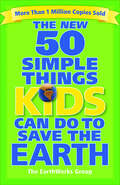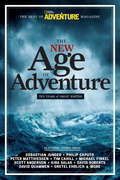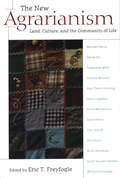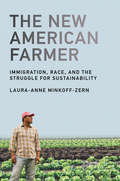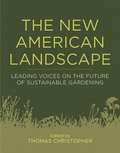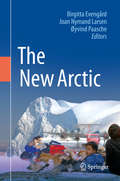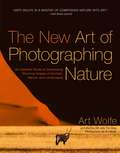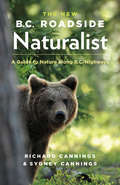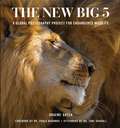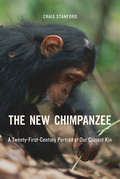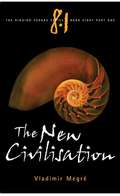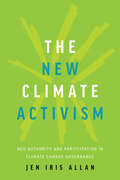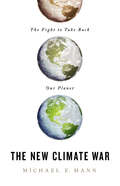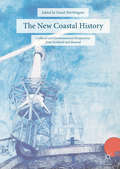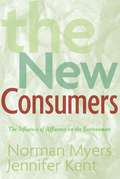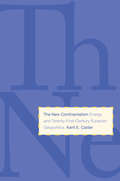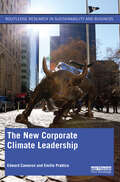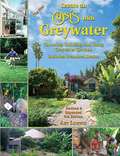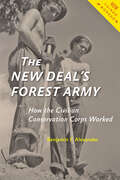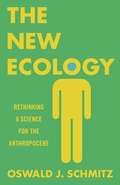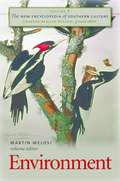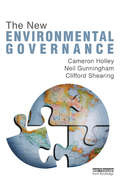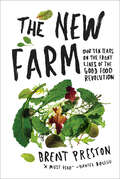- Table View
- List View
The New 50 Simple Things Kids Can Do to Save the Earth
by Sophie Javna EarthWorks GroupIn The New 50 Simple Things Kids Can Do to Save the Earth, Sophie and John have revised the original best-selling book for a concerned and vibrant Web 2.0 youth market. It's easy-to-do and kid-friendly projects show that kids can make a difference, and each chapter is packed with tons of links to groups and resources. What makes this book stand out, though, is that it doesn't just inform kids, it encourages them to make a difference by providing them, their friends and their families the tools to take action.Together, John and Sophie enlighten, educate, and encourage our children with easy and smart ways to save the earth. Pretty darn cool, huh? We thought so. What you can do: Order now and help save the only earth we've got.Mother Earth needs our help now.
The New Age of Adventure
by John RasmusRasmus (founding editor-in-chief, National Geographic Adventure magazine) presents a collection of 25 of the best nonfiction stories from the first decade of Adventure magazine. Written by 20 well-known, prize-winning American journalists, war correspondents, travel writers, naturalists, and novelists, the stories describe experiences from all parts of the globe and in all types of situations, from Sebastian Junger's opening account of a trip to Afghanistan to interview guerilla leader Ahmad Shah Massoud, to Philip Caputo's experience tracking Kenya's man-eating Tsavo lions, Scott Anderson's tale of a coming-of-age road trip across Europe and Asia, and Gretel Ehrlich's story of the nomadic reindeer herders in northwestern Russia. No subject index. Annotation c2010 Book News, Inc. , Portland, OR (booknews. com)
The New Agrarianism: Land, Culture, and the Community of Life
by Eric T. FreyfogleThe engaging writings gathered in this new book explore an important but little-publicized movement in American culture -- the marked resurgence of agrarian practices and values in rural areas, suburbs, and even cities. It is a movement that in widely varied ways is attempting to strengthen society's roots in the land while bringing greater health to families, neighborhoods, and communities. The New Agrarianism vividly displays the movement's breadth and vigor, with selections by such award-winning writers as Wendell Berry, William Kittredge, Stephanie Mills, David Orr, Scott Russell Sanders, and Donald Worster. As editor Eric Freyfogle observes in his introduction, agrarianism is properly conceived in broad terms, as reaching beyond food production to include a wide constellation of ideals, loyalties, sentiments, and hopes. It is a temperament and a moral orientation as well as a suite of diverse economic practices -- all based on the insistent truth that people everywhere are part of the land community, as dependent as other life on its fertility and just as shaped by its mysteries and possibilities. The writings included here have been chosen for their engaging narratives as well as their depiction of the New Agrarianism's broad scope. Many of the selections illustrate agrarian practitioners in action, while other selections offer pointed critiques of contemporary American culture and its market-driven, resource-depleting competitiveness. Together, they reveal what Freyfogle identifies as the heart and soul of the New Agrarianism: its yearning to regain society's connections to the land and its quest to help craft a more land-based and enduring set of shared values. The New Agrarianism offers a compelling vision of this hopeful new way of living. It is an essential book for social critics, community activists, organic gardeners, conservationists, and all those seeking to forge sustaining ties with the entire community of life.
The New American Farmer: Immigration, Race, and the Struggle for Sustainability (Food, Health, and the Environment)
by Laura-Anne Minkoff-ZernAn examination of Latino/a immigrant farmers as they transition from farmworkers to farm owners that offers a new perspective on racial inequity and sustainable farming.Although the majority of farms in the United States have US-born owners who identify as white, a growing number of new farmers are immigrants, many of them from Mexico, who originally came to the United States looking for work in agriculture. In The New American Farmer, Laura-Anne Minkoff-Zern explores the experiences of Latino/a immigrant farmers as they transition from farmworkers to farm owners, offering a new perspective on racial inequity and sustainable farming. She finds that many of these new farmers rely on farming practices from their home countries—including growing multiple crops simultaneously, using integrated pest management, maintaining small-scale production, and employing family labor—most of which are considered alternative farming techniques in the United States.Drawing on extensive interviews with farmers and organizers, Minkoff-Zern describes the social, economic, and political barriers immigrant farmers must overcome, from navigating USDA bureaucracy to racialized exclusion from opportunities. She discusses, among other topics, the history of discrimination against farm laborers in the United States; the invisibility of Latino/a farmers to government and universities; new farmers' sense of agrarian and racial identity; and the future of the agrarian class system.Minkoff-Zern argues that immigrant farmers, with their knowledge and experience of alternative farming practices, are—despite a range of challenges—actively and substantially contributing to the movement for an ecological and sustainable food system. Scholars and food activists should take notice.
The New American Landscape: Leading Voices on the Future of Sustainable Gardening
by Thomas ChristopherGardeners are the front line of defense in our struggle to tackle the problems of global warming, loss of habitat, water shortages, and shrinking biodiversity. In The New American Landscape, author and editor Thomas Christopher brings together the best thinkers on the topic of gardening sustainably, and asks them to describe the future of the sustainable landscape. The discussion unfolds from there, and what results is a collective vision as eloquent as it is diverse.The New American Landscape offers designers a roadmap to a beautiful garden that improves, not degrades the environment. It’s a provocative manifesto about the important role gardens play in creating a more sustainable future that no professional garden designer can afford to miss. John Greenlee and Neil Diboll on the new American meadow gardenRick Darke on balancing natives and exotics in the gardenDoug Tallamy on landscapes that welcome wildlifeEric Toensmeier on the sustainable edible gardenDavid Wolfe on gardening sustainable with a changing climateElaine Ingham on managing soil healthDavid Deardorff and Kathryn Wadsworth on sustainable pest solutionsEd Snodgrass and Linda McIntyre on green roofs in the sustainable residential landscapeThomas Christopher on waterwise gardensToby Hemenway on whole system garden designThe Sustainable Site Initiative on the managing the home landscape as a sustainable site
The New Arctic
by Birgitta Evengård Joan Nymand Larsen Øyvind PaascheIn the late 18th century explorers and scientists started venturing into the Arctic in a heroic and sometimes deadly effort to understand and unveil the secrets of the unforgiving and mysterious polar region of the high north. Despite that the Arctic was already populated mattered less for the first wave of polar researchers and explorations who nevertheless, brought back valuable knowledge. Today the focus in Arctic science and discourse has changed to one which includes the peoples and societies, and their interaction with the world beyond. The image of a static Arctic - heralded first by explorers - prevailed for a long time, but today the eyes of the World see the Arctic very differently. Few, if any, other places on Earth are currently experiencing the kind of dramatic change witnessed in the Arctic. According to model forecasts, these changes are likely to have profound implications on biophysical and human systems, and will accelerate in the decades to come. "The New Arctic" highlights how, and in what parts, the natural and political system is being transformed. We're talking about a region where demography, culture, and political and economic systems are increasingly diverse, although many common interests and aspects remain; and with the new Arctic now firmly placed in a global context. Settlements range from small, predominantly indigenous communities, to large industrial cities, and all have a link to the surrounding environment, be it glaciers or vegetation or the ocean itself. "The New Arctic" contributes to our further understanding of the changing Arctic. It offers a range of perspectives, which reflect the deep insight of a variety of scientific scholars across many disciplines bringing a wide range of expertise. The book speaks to a broad audience, including policy-makers, students and scientific colleagues.
The New Art of Photographing Nature: An Updated Guide to Composing Stunning Images of Animals, Nature, and Landscapes
by Art Wolfe Martha HillA new spin on the classic guide to composing stunning images of nature and wildlife What is the difference between a good picture and a great one? In this fully revised edition of the classic bestseller The Art of Photographing Nature, master photographer Art Wolfe and former Audubon photo editor Martha Hill team up to explain the art of composing images of enduring beauty. Against a backdrop of more than 250 photographs of nature, wildlife, and landscapes, they share insights and advice about what works and what doesn't, and how small changes can take an image from ordinary to extraordinary. Throughout, all-new tips from digital imaging expert Tim Grey show readers how to make the most of digital technology, whether by choosing the right color space, understanding sensor size, or removing distracting elements in post-processing. The result is an invaluable collection of expert advice updated for the modern age.
The New B.C. Roadside Naturalist
by Richard Cannings Sydney CanningsIn this fascinating guide to the roadside ecology of the major highways in B.C., you'll discover a whole new dimension to taking a car trip. This new edition has been updated and expanded to cover northern British Columbia and southern Yukon, giving readers a unique perspective on the northern wildlife and vegetation. Southern travellers "may find that this journey will redefine what 'northern British Columbia' means to them, or even what 'north' means."Sidebars tell stories about various species, such as the huge, endangered sturgeon and the Great Basin spadefoot toad, which spends most of the year underground. Full-colour photographs and black-and-white drawings illustrate numerous plants and animals that make their homes along the roadsides of British Columbia, and maps show the route of each highway discussed. In addition, the book offers suggestions for where to stop and look for crayfish, enjoy a swim in summer, or have a picnic lunch during your travels. An appendix provides a brief field guide of tree silhouettes and hints for identifying trees and shrubs.Whether you're taking a day trip or a two-week holiday, your drive along the highways of B.C. will be enriched by the storehouse of information in this facinating and informative guide.
The New Big 5
by Graeme GreeneThe world&’s wildlife is in crisis, and the next ten years are critical.The New Big 5 brings together more than 145 of the world&’s greatest wildlife photographers, conservationists, and advocates in a mission to not only celebrate the natural beauty of the animal world, but to raise awareness of the crucial issues facing these magnificent creatures. Until recently, the Big Five referred to the five big-game animals that were most difficult for colonial hunters to shoot and kill. Wildlife photographer Graeme Green&’s The New Big 5 Project set about to reclaim that gruesome, antiquated term by asking people around the world to vote on the five endangered animals they would most want to shoot—with a camera. More than fifty thousand people voted, and the New Big 5 list of Wildlife Photography was born. What are the New Big 5? Elephants Gorillas Tigers Lions Polar Bears With 226 stunning photos and informative essays from the world&’s greatest wildlife advocates, this one-of-a-kind book inspires and raises awareness about the New Big 5, and our wildlife world. FEATURES MANY OTHER ENDANGERED SPECIES: An extensive chapter is devoted to endangered species, such as rhinos, cheetahs, lemurs, frogs, vultures, sharks, whales, and turtles. INCREDIBLE CREATIVE PHOTOGRAPHY: Majestic portraits, animals in their habitat, and examples of natural behavior from more than 145 renowned wildlife photographers, including Ami Vitale, Marsel van Oosten, Paul Nicklen, Steve McCurry, Karine Aigner, Brian Skerry, Lucas Bustamante, Beverly Joubert, Clement Kiragu, Thomas Mangelsen, Paul Hilton, Suzi Eszterhas, Sascha Fonseca, Cristina Mittermeier, Frans Lanting, Marina Cano, Gael R. Vande Weghe, Daisy Gilardini, Steve Winter, Qiang Zhang, Art Wolfe, Dhritiman Mukherjee, Will Burrard-Lucas, David Lloyd, Vicki Jauron, Sergey Gorshkov, and Thomas Vijayan. ENGAGING ESSAYS from leading conservationists, including Dr. Jane Goodall, Dr. Paula Kahumbu (Wildlife Direct), Dr. Tara Stoinski (CEO, Dian Fossey Gorilla Fund), Krista Wright (Executive Director, Polar Bears International), Dr. Anish Andheria (CEO, Wildlife Conservation Trust), Dr. Moreangels Mbizah (Executive Director, Wildlife Conservation Action), Dominique Gonçalves (Manager, Elephant Ecology Project at Gorongosa National Park), and Wes Sechrest (CEO, Re:wild). &“I hope the photos in this The New Big 5 book will lead people into the wonderful worlds of these iconic species - elephants, polar bears, gorillas, tigers and lions - and encourage them to explore the lives of so many other fascinating creatures, many of which are also endangered. Then, perhaps, other people will become involved in helping to create a world where wildlife can flourish for future generations to enjoy. I believe we have a window of time during which we can start to heal some of the harm we have inflicted on the natural world and slow down the heating of the planet. But only if we get together and take action now.&” - Dr. Jane Goodall
The New Chimpanzee: A Twenty-First-Century Portrait of Our Closest Kin
by Craig StanfordRecent discoveries about wild chimpanzees have dramatically reshaped our understanding of these great apes and their kinship with humans. We now know that chimpanzees not only have genomes similar to our own but also plot political coups, wage wars over territory, pass on cultural traditions to younger generations, and ruthlessly strategize for resources, including sexual partners. In The New Chimpanzee, Craig Stanford challenges us to let apes guide our inquiry into what it means to be human. With wit and lucidity, Stanford explains what the past two decades of chimpanzee field research has taught us about the origins of human social behavior, the nature of aggression and communication, and the divergence of humans and apes from a common ancestor. Drawing on his extensive observations of chimpanzee behavior and social dynamics, Stanford adds to our knowledge of chimpanzees’ political intelligence, sexual power plays, violent ambition, cultural diversity, and adaptability. The New Chimpanzee portrays a complex and even more humanlike ape than the one Jane Goodall popularized more than a half century ago. It also sounds an urgent call for the protection of our nearest relatives at a moment when their survival is at risk.
The New Civilisation (The Ringing Cedars Series #8, Part #1)
by Vladimir Megré John Woodsworth Leonid Sharashkin"The New Civilisation" is Book 8 Part 1 of The Ringing Cedars Book Series. This series of nine books tells the story of a remarkable woman named Anastasia, discovered in 1995 by a Siberian trader, Vladimir Megré, while he was plying the waters of the remote Ob River. Anastasia was born in the forest in 1969 to parents who died tragically when she was just a baby. Living for the most part without warm clothes, food cultivation or man-made shelter, she has survived on fruit, nuts, berries and mushrooms, brought to her by "wild" animals with which she lives in peaceful harmony. Megré initially spent three days with Anastasia, during which time she displayed such astounding knowledge, power and wisdom that he abandoned his business and, at her request, began writing this series. She told him she would encode the books with an energy that would cause them to sell in the millions. Despite his lack of writing experience, this is exactly what happened. It is Anastasia's ability to strike a chord in the heart of the reader that makes these books so very unusual. The purity and power of her words is provoking an outpouring of joy and hope in people from all walks of life.
The New Climate Activism: NGO Authority and Participation in Climate Change Governance
by Jen AllanAt the 2019 UN climate change conference, activists and delegates for groups representing Indigenous, youth, women, and labour rights were among those marching through the halls chanting "Climate Justice, People Power." In The New Climate Activism, Jen Iris Allan looks at why and how these social activists came to participate in climate change governance while others, such as those working on human rights and health, remain on the outside of climate activism. Through case studies of women’s rights, labour, alter-globalization, health, and human rights activism, Allan shows that some activists sought and successfully gained recognition as part of climate change governance, while others remained marginalized. While concepts key to some social activists, including gender mainstreaming, just transition, and climate justice are common terms, human rights and health remain "fringe issues" in climate change governance. The New Climate Activism explores why and how these activists brought their issues to climate change, and why some succeeded while others did not.
The New Climate War: The Fight to Take Back Our Planet
by Michael E. MannA renowned climate scientist shows how fossil fuel companies have waged a thirty-year campaign to deflect blame and responsibility and delay action on climate change, and offers a battle plan for how we can save the planet. Recycle. Fly less. Eat less meat. These are some of the ways that we've been told can slow climate change. But the inordinate emphasis on individual behavior is the result of a marketing campaign that has succeeded in placing the responsibility for fixing climate change squarely on the shoulders of individuals.Fossil fuel companies have followed the example of other industries deflecting blame (think "guns don't kill people, people kill people") or greenwashing (think of the beverage industry's "Crying Indian" commercials of the 1970s). Meanwhile, they've blocked efforts to regulate or price carbon emissions, run PR campaigns aimed at discrediting viable alternatives, and have abdicated their responsibility in fixing the problem they've created. The result has been disastrous for our planet.In The New Climate War, Mann argues that all is not lost. He draws the battle lines between the people and the polluters-fossil fuel companies, right-wing plutocrats, and petrostates. And he outlines a plan for forcing our governments and corporations to wake up and make real change, including:a common-sense, attainable approach to carbon pricing- and a revision of the well-intentioned but flawed currently proposed version of the Green New Deal;allowing renewable energy to compete fairly against fossil fuelsdebunking the false narratives and arguments that have worked their way into the climate debate and driven a wedge between even those who support climate change solutionscombatting climate doomism and despair-mongering With immensely powerful vested interests aligned in defense of the fossil fuel status quo, the societal tipping point won't happen without the active participation of citizens everywhere aiding in the collective push forward. This book will reach, inform, and enable citizens everywhere to join this battle for our planet.
The New Coastal History
by David WorthingtonThis book provides a pathway for the New Coastal History. Our littorals are all too often the setting for climate change and the political, refugee and migration crises that blight our age. Yet historians have continued, in large part, to ignore the space between the sea and the land. Through a range of conceptual and thematic chapters, this book remedies that. Scotland, a country where one is never more than fifty miles from saltwater, provides a platform as regards the majority of chapters, in accounting for and supporting the clusters of scholarship that have begun to gather around the coast. The book presents a new approach that is distinct from both terrestrial and maritime history, and which helps bring environmental history to the shore. Its cross-disciplinary perspectives will be of appeal to scholars and students in those fields, as well as in the environmental humanities, coastal archaeology, human geography and anthropology.
The New Consumers: The Influence Of Affluence On The Environment
by Jennifer Kent Norman MyersWhile overconsumption by the developed world's roughly one billion inhabitants is an abiding problem, another one billion increasingly affluent "new consumers" in developing countries will place additional strains on the earth's resources, argue authors Norman Myers and Jennifer Kent in this important new book. The New Consumers examines the environmental impacts of this increased consumption, with particular focus on two commodities -- cars and meat -- that stand to have the most far-reaching effects. It analyzes consumption patterns in a number of different countries, with special emphasis on China and India (whose surging economies, as well as their large populations, are likely to account for exceptional growth in humanity's ecological footprint), and surveys big-picture issues such as the globalization of economies, consumer goods, and lifestyles. Ultimately, according to the orman Myers and Jennifer Kent, the challenge will be for all of humanity to transition to sustainable levels of consumption, for it is unrealistic to expect "new" consumers not to aspire to be like the "old" ones. Cogent in its analysis, The New Consumers issues a timely warning of a major and developing environmental trend, and suggests valuable strategies for ameliorating its effects.
The New Continentalism
by Kent E. CalderIn this groundbreaking book Kent E. Calder argues that a new transnational configuration is emerging in Asia, driven by economic growth, rising energy demand, and the erosion of longstanding geopolitical divisions. What Calder calls the New Silk Road—with a strengthening multi-faceted relationship between East Asia and the Middle East at its core—could eventually emerge as one of the world’s most important multilateral configurations. Straddling the border between comparative politics and international relations theory, this important book will stimulate debate and discussion in both fields.
The New Corporate Climate Leadership (Routledge Research in Sustainability and Business)
by Edward Cameron Emilie PratticoThis book provides a comprehensive treatment of the role of the private sector in accelerating the transition to a low-carbon, climate-resilient, and inclusive world. In the lead up to and since the historic Paris Agreement on climate change, more than 6,000 companies from 120 countries representing more than $36.5 trillion in revenue have made climate commitments. Examining this trend, The New Corporate Climate Leadership provides a clear synthesis of the relationship between the real economy and climate change and offers a state-of-the-art assessment of corporate initiatives that focus on greenhouse gas emissions reductions and the management of climate risk through enhanced resilience. It debates the relative merits of incremental and sequenced ambition versus radical systems change – including a critique of the prevailing capitalist approach to climate change – and provides an actionable guide to skills development for change-makers in the shift toward a low-carbon world. Drawing on perspectives from leading thinkers inside the private sector, across government, and within civil society to truly interrogate the scale, scope, and speed of progress, this book provides a clear vision for what the next generation of corporate climate leadership should look like. Optimistic in tone, this book will be of great interest to students, scholars, and practitioners of climate change and sustainable business.
The New Create an Oasis With Greywater:Choosing, Building, and Using Greywater Systems (5th Edition)
by Art LudwigThis book describes how to choose, build, and use 20 types of residential greywater reuse systems in just about any context: urban, rural, or village.
The New Deal's Forest Army: How the Civilian Conservation Corps Worked (How Things Worked)
by Benjamin F. AlexanderHow the Civilian Conservation Corps constructed, rejuvenated, and protected American forests and parks at the height of the Great Depression.Propelled by the unprecedented poverty of the Great Depression, President Franklin D. Roosevelt established an array of massive public works programs designed to provide direct relief to America’s poor and unemployed. The New Deal’s most tangible legacy may be the Civilian Conservation Corps’s network of parks, national forests, scenic roadways, and picnic shelters that still mark the country’s landscape. CCC enrollees, most of them unmarried young men, lived in camps run by the Army and worked hard for wages (most of which they had to send home to their families) to preserve America’s natural treasures. In The New Deal’s Forest Army, Benjamin F. Alexander chronicles how the corps came about, the process applicants went through to get in, and what jobs they actually did. He also explains how the camps and the work sites were run, how enrollees spent their leisure time, and how World War II brought the CCC to its end. Connecting the story of the CCC with the Roosevelt administration’s larger initiatives, Alexander describes how FDR’s policies constituted a mixed blessing for African Americans who, even while singled out for harsh treatment, benefited enough from the New Deal to become an increasingly strong part of the electorate behind the Democratic Party. The CCC was the only large-scale employment program whose existence FDR foreshadowed in speeches during the 1932 campaign—and the dearest to his heart throughout the decade that it lasted. Alexander reveals how the work itself left a lasting imprint on the country’s terrain as the enrollees planted trees, fought forest fires, landscaped public parks, restored historic battlegrounds, and constructed dams and terraces to prevent floods. A uniquely detailed exploration of life in the CCC, The New Deal’s Forest Army compellingly demonstrates how one New Deal program changed America and gave birth to both contemporary forestry and the modern environmental movement.
The New Ecology: Rethinking a Science for the Anthropocene
by Oswald J. SchmitzHow the science of ecology is changing to meet the daunting challenges of environmental sustainabilityOur species has transitioned from being one among millions on Earth to the species that is single-handedly transforming the entire planet to suit its own needs. In order to meet the daunting challenges of environmental sustainability in this epoch of human domination—known as the Anthropocene—ecologists have begun to think differently about the interdependencies between humans and the natural world. This concise and accessible book provides the best available introduction to what this new ecology is all about—and why it matters more than ever before.Oswald Schmitz describes how the science of ecology is evolving to provide a better understanding of how human agency is shaping the natural world, often in never-before-seen ways. The new ecology emphasizes the importance of conserving species diversity, because it can offer a portfolio of options to keep our ecosystems resilient in the face of environmental change. It envisions humans taking on new roles as thoughtful stewards of the environment to ensure that ecosystems have the enduring capacity to supply the environmental services on which our economic well-being—and our very existence—depend. It offers the ecological know-how to maintain and enhance our planet's environmental performance and ecosystem production for the benefit of current and future generations.Informative and engaging, The New Ecology shows how today’s ecology can provide the insights we need to appreciate the crucial role we play in this era of unprecedented global environmental transition.
The New Economy of Nature
by Gretchen C. Daily Catherine EllisonHow to use the environment profitably.
The New Encyclopedia of Southern Culture: Environment
by Martin MelosiFrom semitropical coastal areas to high mountain terrain, from swampy lowlands to modern cities, the environment holds a fundamental importance in shaping the character of the American South. This volume of The New Encyclopedia of Southern Culture surveys the dynamic environmental forces that have shaped human culture in the region--and the ways humans have shaped their environment. Articles examine how the South's ecology, physiography, and climate have influenced southerners--not only as a daily fact of life but also as a metaphor for understanding culture and identity. This volume includes ninety-eight essays that explore--both broadly and specifically--elements of the southern environment. Thematic overviews address subjects such as plants, animals, energy use and development, and natural disasters. Shorter topical entries feature familiar species such as the alligator, the ivory-billed woodpecker, kudzu, and the mockingbird. Also covered are important individuals in southern environmental history and prominent places in the landscape, such as the South's national parks and seashores. New articles cover contemporary issues in land use and conservation, environmental protection, and the current status of the flora and fauna widely associated with the South.
The New Entrants Problem in International Fisheries Law
by Andrew SerdyAre international fisheries heading away from open access to a global commons towards a regime of property rights? The distributional implications of denying access to newcomers and re-entrants that used the resource in the past are fraught. Should the winners in this process compensate the losers and, if so, how? Regional Fisheries Management Organisations, in whose gift participatory rights increasingly lie, are perceptibly shifting their attention to this approach, which has hitherto been little analysed; this book provides a review of the practice of these bodies and the States that are their members. The recently favoured response of governments, combating 'IUU' - illegal, unregulated and unreported - fishing, is shown to rest on a flawed concept, and the solution might lie less in law than in legal policy: compulsory dispute settlement to moderate their claims and an expansion of the possibilities of trading of quotas to make solving the global overcapacity issue easier.
The New Environmental Governance
by Clifford Shearing Cameron Holley Neil GunninghamA bold and profoundly new way of governing environmental problems is palpable around the globe and aims to overcome the limitations of the interventionist state and its market alternative to offer more effective and legitimate solutions to today's most pressing environmental problems. The 'new environmental governance' (NEG) emphasises a host of novel characteristics including participation, collaboration, deliberation, learning and adaptation and 'new' forms of accountability. While these unique features have generated significant praise from legal and governance scholars, there have been very few systematic evaluations of NEG in practice, and it is still unclear whether NEG will in fact 'work', and if so, when and how. This book offers one of the most rigorous research investigations into cutting edge trends in environmental governance to date. Focusing its inquiry around some of the most central, controversial and/or under researched characteristics of NEG, the book offers fresh insights into the conditions under which we can best achieve successful collaboration, effective learning and adaptation, meaningful participatory and deliberative governance and effective forms of accountability. The book synthesizes its findings to identify seven key pillars of 'good' NEG that are central to its success and will provide useful guidance for policymakers and scholars seeking to apply new governance to a wide range of environmental and non-environmental policy contexts. The book also advances our understanding of State governance and will be a valuable reference for scholars, researchers and students working in law and regulation studies - especially in the field of environmental law.
The New Farm: Our Ten Years on the Front Lines of the Good Food Revolution
by Brent PrestonThis “must-read” memoir of human-scale agriculture offers an insider’s view of today’s food system by a leading voice in sustainable farming (Daniel Boulud). After years of working at the ends of the earth in human rights and development, Brent Preston and his wife were die-hard city dwellers. But when their second child arrived, the shine came off urban living. In 2003 they bought a hundred acres and a rundown farmhouse, determined to build a farm that would sustain their family, nourish their community, heal their environment—and turn a profit. The New Farm is Preston’s memoir of a decade of toil and perseverance. Farming is a complex and precarious business, and they made plenty of mistakes along the way. But as they learned how to grow food, and to succeed at the business of farming, they also found that a small, sustainable, organic farm could be an engine for change, a path to a more just and sustainable food system. Today, The New Farm supplies top restaurants, supports community food banks, hosts events with leading chefs, and grows extraordinary produce. Told with humor and heart, The New Farm is a joy, a passionate book by an important new voice.
